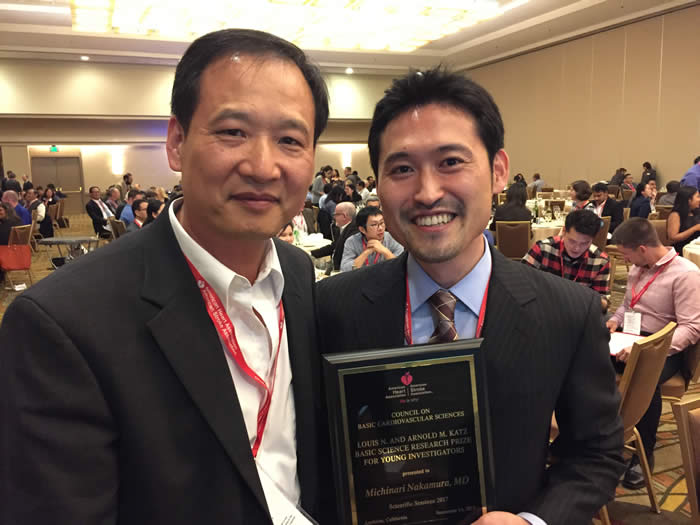Department News
On behalf of Dr. Sadoshima, please join us in congratulating Maha on being selected to receive $20,000 in free services from Active Motif: https://www.activemotif.com/services-grant-comp
Posted 5/24/18
Congratulations to Dr. Michinari Nakamura for winning the prestigious Louis N. and Arnold M. Katz Basic Research Prize at the 2017 AHA Scientific Sessions!!

Dr. Nakamura (pictured right) holding the First Prize plaque
Dr. Gopal Babu and his colleagues have recently published an article in Nature Communications on the therapeutic role of sarcolipin downregulation in mitigating Duchenne muscular dystrophy. The summary of the study is given below.
Sarcolipin (SLN) is an inhibitor of the sarco/endoplasmic reticulum (SR) Ca2+ ATPase (SERCA) and is abnormally elevated in the muscle of Duchenne muscular dystrophy (DMD) patients and animal models. We show that reducing SLN levels ameliorates dystrophic DMD. Germline inactivation of one allele of the SLN gene normalizes SLN expression, restores SERCA function, mitigates skeletal muscle and cardiac pathology, improves muscle regeneration, and extends the lifespan. To translate our findings into a therapeutic strategy, we knock down SLN expression in 1-month old mdx:utr−/− mice via adeno-associated virus (AAV) 9-mediated RNA interference. The AAV treatment markedly reduces SLN expression, attenuates muscle pathology and improves diaphragm, skeletal muscle and cardiac function. Taken altogether, our findings suggest that SLN reduction is a promising therapeutic approach for DMD.
The full article can be downloaded from the following link: http://rdcu.be/w2CB
Posted 10/20/17
Drs. Michinari Nakamura and Shohei Ikeda will each be competing as one of five finalists for the prestigious Louis N. and Arnold M. Katz Basic Research Prize and Melvin L. Marcus Young Investigator Award, respectively, at the AHA Scientific Sessions in November 2017.
Posted 10/12/17
Dr. Andreas Ivessa has recently published in the Trends in Cancer review journal. Summary as follows.
When human cells become older, they usually acquire various types of chromosomal changes including shorter telomeres, deletions/insertions and chromosome translocations. These chromosomal alterations may either contribute to the induction of age-dependent diseases or facilitate the development of cancer. Since studying these changes in mammalian cells can be technically difficult, Dr. Ivessa’s laboratory uses baker’s yeast as a simple model system to understand chromosomal changes during aging. Usually the chromosomal replication process isn’t that smooth. Replication may slow down and stall at specific, fragile sites, which may lead to DNA breakage. Since genomic instability increases during aging, pausing/stalling of the replication process was expected also to be increased at the fragile sites. However, in a recent publication in Cell Reports, Cabral et al.1, 2 discovered that pausing/stalling at the fragile sites indeed decreased in aging yeast cells. The reduced pausing resulted from the absence of non-histone protein complexes, which bind to these sites and cause replication slowing. Lack of binding of these proteins to the fragile sites is caused by a deficiency in the nuclear protein import in aging cells. Future investigations focus on elucidating the mechanisms, how chromosomal instabilities in aging cells contribute to the induction of age-dependent diseases and cancer.
- Cabral, M., Cheng, X., Singh, S., Ivessa, A.S. Absence of non-histone protein complexes at natural chromosomal pause sites results in reduced replication pausing in aging yeast cells. Cell Reports, 2016 Nov 8;17(7):1747-1754. PMID: 27829146
- Ivessa, A.S. Aging: Fewer obstacles in DNA replication? Trends in Cancer, “Forum” review-article, 2017 May 05. (Epub ahead of print).
This work has been supported by the National Institutes of Health (R21AG047423).
Posted 9/20/17
Dr. Michinari Nakamura was awarded an AHA Scientist Development Grant entitled "The Role of Bcl-x Short Isoform in Heart Failure"
Eric Himelman, a graduate student in Dr. Fraidenraich’s lab, has recently been awarded a two-year American Heart Association (AHA) predoctoral fellowship for his project: “Genetic Rescue of Connexin 43 Lateralization in DMD-induced Cardiomyopathy”
For his project, Eric investigates the role of the gap-junction protein Connexin 43 (Cx43) in the development of cardiomyopathy in mice with Duchenne Muscular Dystrophy (DMD). Eric has honed in on a specific Cx43 post-translational modification (PTM) that he believes is a powerful contributor towards Cx43 remodeling, a pathological event that occurs in DMD cardiomyocytes. To investigate his hypothesis, Eric has generated knock-in DMD mouse lines with mutations that confer either a promotion or inhibition of the Cx43-PTM. Thus far, Eric has observed a significant rescue from pathology in the mutant DMD mouse model. Both Eric and the AHA believe that this project will provide critical insights into the development of DMD cardiomyopathy and will yield fundamental therapeutic approaches for the severe disease.
Posted 7/24/17
